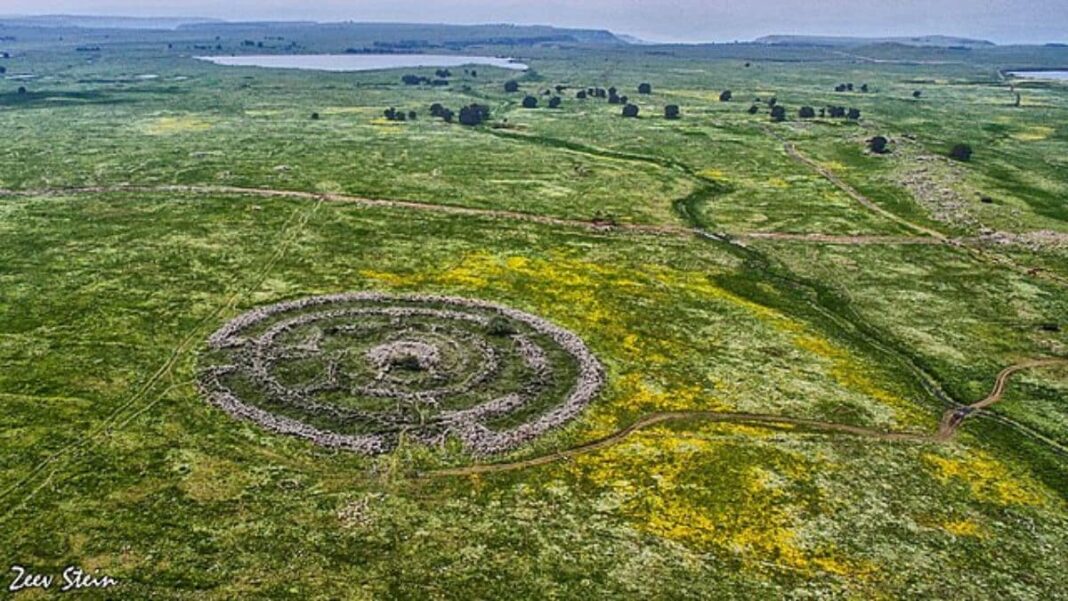Title: Rujm el-Hiri Re-Evaluated: A New Perspective on the Ancient Site
The ancient site of Rujm el-Hiri, also known as the "Wheel of Ghosts," located in the Golan Heights, has long been shrouded in mystery. Recent re-evaluations of this archaeological wonder have challenged established theories, shedding new light on its enigmatic past. Let’s delve into the geophysical insights and advanced techniques that have transformed our understanding of this ancient structure.
The Story So Far: Unraveling the Mysteries of Rujm el-Hiri
Imagine a time long ago, in the heart of the Golan Heights, where a mysterious structure stood tall, captivating the minds of all who beheld it. Rujm el-Hiri, with its towering walls and intricate design, was believed to be an astronomical observatory, a link between the heavens and the earth. However, recent studies have unveiled a different truth, one that challenges our preconceived notions and invites us to explore the untold stories hidden within its ancient stones.
Geophysical Insights Challenge Established Theories
In a groundbreaking study published in Remote Sensing, researchers from Tel Aviv University and Ben-Gurion University, led by Dr. Olga Khabarova and Prof. Lev Eppelbaum, have revealed startling discoveries about Rujm el-Hiri. Through advanced geophysical techniques, they have uncovered evidence that geodynamic movements spanning millions of years have altered the site’s orientation, casting doubts on its celestial purpose. The once-thought alignment with celestial patterns has been debunked, raising questions about the true intent behind this ancient marvel.
Advanced Techniques Reveal Archaeological Landscape
Utilizing cutting-edge geomagnetic analysis and satellite technology, the research team has unearthed a hidden landscape surrounding Rujm el-Hiri. Within a 30-kilometre radius of the Sea of Galilee, circular structures, burial mounds, and round enclosures have been discovered, painting a vivid picture of ancient life in the region. These findings suggest a more practical role for the site, hinting at agricultural and herding activities rather than purely ceremonial or astronomical functions.
A Broader Perspective on Rujm el-Hiri’s Role
Dr. Michal Birkenfeld of Ben-Gurion University emphasizes the significance of this reassessment in enriching our understanding of ancient communities in the Golan Heights. By challenging traditional assumptions and highlighting the site’s integration into a larger archaeological landscape, this study opens new avenues for exploration and invites us to reevaluate our perceptions of how ancient civilizations interacted with their environment.
Conclusion
The re-evaluation of Rujm el-Hiri marks a pivotal moment in our understanding of this ancient site. As we unravel the mysteries of the past and embrace new perspectives, we are reminded of the ever-evolving nature of archaeology and the endless possibilities for discovery. Rujm el-Hiri stands as a testament to the resilience of history, urging us to look beyond the stars and explore the rich tapestry of human existence etched in stone.
Frequently Asked Questions
- What is Rujm el-Hiri?
- Rujm el-Hiri is an ancient site in the Golan Heights, often referred to as the "Wheel of Ghosts."
- What was the original purpose of Rujm el-Hiri?
- Previous interpretations suggested it was an astronomical observatory, but recent studies have challenged this theory.
- Who led the research on Rujm el-Hiri’s re-evaluation?
- The study was conducted by researchers from Tel Aviv University and Ben-Gurion University, led by Dr. Olga Khabarova and Prof. Lev Eppelbaum.
- What advanced techniques were used in the study?
- Geomagnetic analysis and satellite technology were employed to uncover the surrounding archaeological features.
- What new insights were gained from the re-evaluation of Rujm el-Hiri?
- The site’s orientation was found to have shifted over millions of years, leading to a reevaluation of its original purpose.
- What does the discovery of surrounding circular structures suggest?
- The presence of circular structures hints at agricultural and herding activities in the region.
- How does the reassessment of Rujm el-Hiri impact our understanding of ancient life in the Golan Heights?
- It enriches our understanding by highlighting the site’s role in a broader archaeological landscape.
- Why is the study significant in the field of archaeology?
- It challenges established theories and encourages further exploration of ancient communities and their interactions.
- What implications does the re-evaluation of Rujm el-Hiri have for future research?
- It opens up new avenues for exploration and prompts a reevaluation of past assumptions.
- Where can I learn more about the study on Rujm el-Hiri?
- For more information, you can refer to the study published in Remote Sensing or articles from reputable sources like Phys.org and SciTech Daily.
Tags: Rujm el-Hiri, Golan Heights, Archaeology, Ancient Sites, Geophysical Analysis, Remote Sensing, Tel Aviv University, Ben-Gurion University, Ancient Civilizations.
- For more information, you can refer to the study published in Remote Sensing or articles from reputable sources like Phys.org and SciTech Daily.

